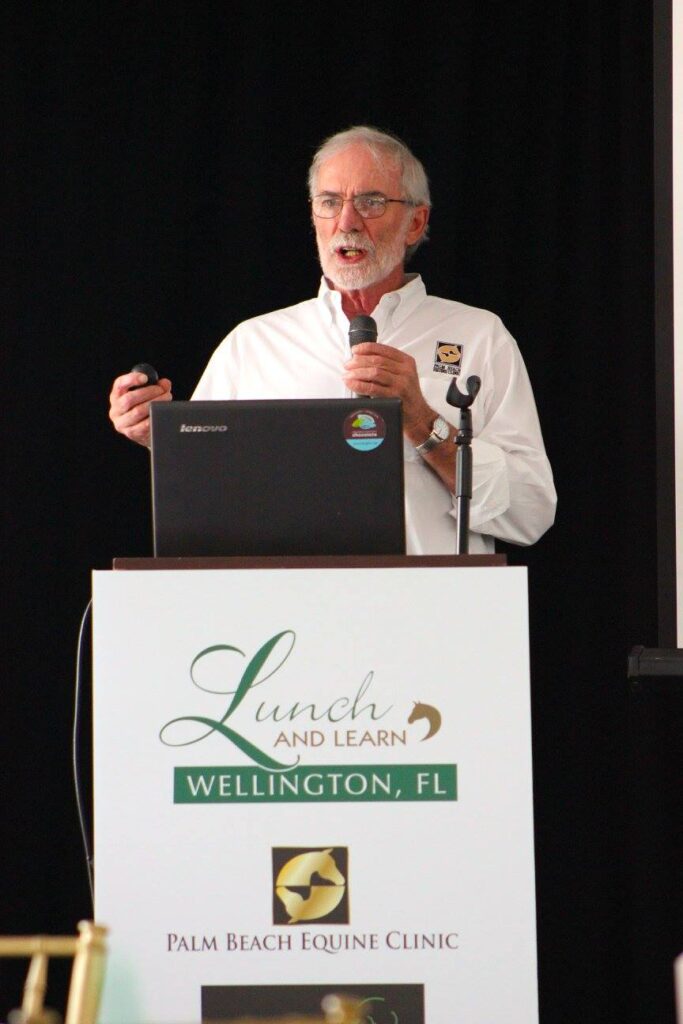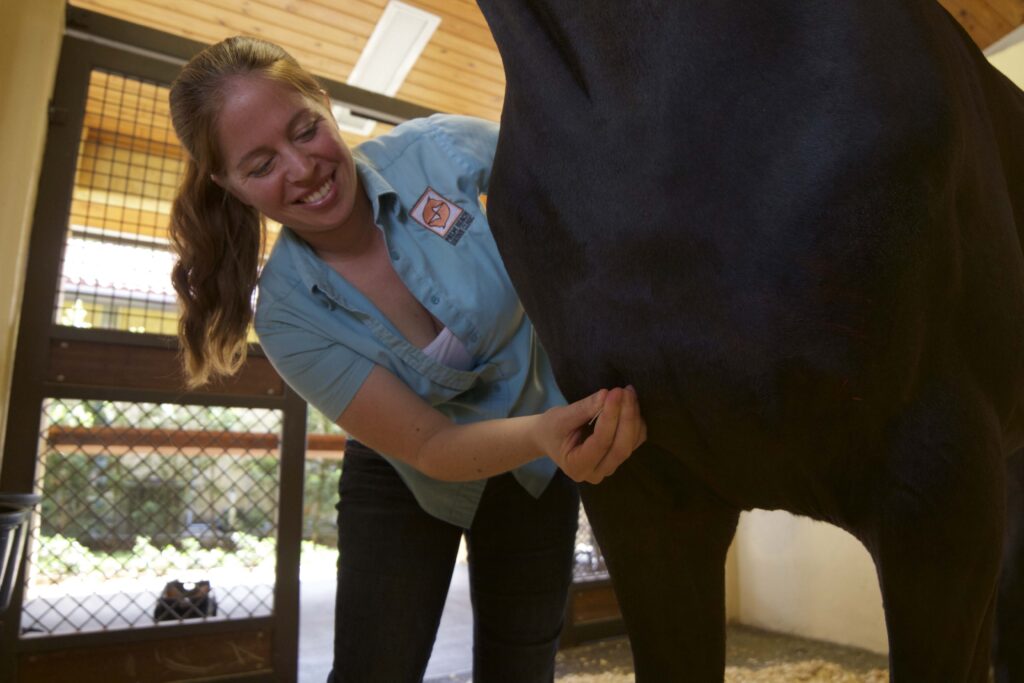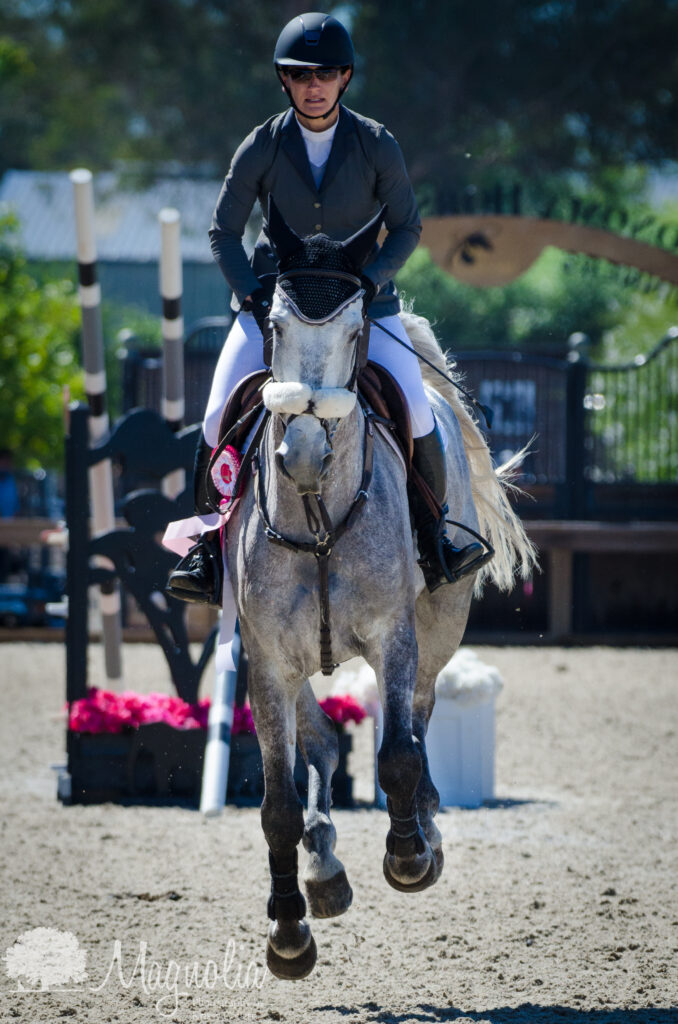Today’s competitive sport horses are asked to perform at their absolute best at the most prestigious competitions all over the world. Travel and life at the showgrounds can be extremely stressful for horses. Ulcers can affect any horse, but competitive sport horses with the extra stressors from a life of intensive work and travel are especially prone. Palm Beach Equine Clinic veterinarians want to ensure that your horse remains healthy and ulcer-free. There are many precautions that can be taken to prevent ulcers from developing, but if your horse does develop a problem, Palm Beach Equine Clinic is there to aid in treatment.
Gastric Ulcers and Hindgut Ulcers
There are two different kinds of ulcers – gastric ulcers and hindgut ulcers. The horse can develop one or the other, or both in combination, however gastric ulcers are most common. Gastric ulcers develop in the stomach, which is comprised of two different halves. The lower half of the stomach secretes acid and digestive enzymes to properly digest food. If the acid splashes up to the upper half of the stomach, there is minimal protection and causes painful erosion of the stomach lining.
Increased acidity in the stomach increases the chance of that acid will come in contact with the larger, unprotected portion, resulting in damage to the stomach lining. There are many different factors that can change the environment of the stomach and cause increased acid production, ultimately resulting in ulcers. The most common factors are drastic changes in feeding times or types of feed, undue stress, and corrosive medications.
Ulcer Prevention in Show Horses
For the competitive equine, the stress of traveling and showing, as well as any change in the environment or increased work, can increase the chances of ulcers forming. Abnormal sleep patterns at shows can cause added stress. It is important to ensure that the horse has ample bedding and space to feel comfortable enough to lay down to rest. Joint pain or other physical pain can also cause unnecessary stress to the horse’s system. Joint supplements, routine injections, and alternative therapies such as chiropractic and acupuncture can be used to keep the horse comfortable and stress-free.
Another major cause of gastric ulcers is chronic administration of phenybutazone (bute), banamine, or other nonsteroidal anti-inflammatory drugs (NSAIDs) as these medications can be corrosive to the stomach lining.
Diagnosing Equine Ulcers
Ulcers can be difficult to diagnose as early signs can easily be confused with colic. Many times horses with ulcers show mild, chronic, colic-like symptoms that resolve fairly quickly. Owners and trainers may notice that the horse seems sore after eating, denies feed entirely, or has colic-like symptoms such as upper lip movement, biting at its side, or pawing. If the ulcer is undiagnosed and is given banamine to treat the colic symptoms, ulcers can be exacerbated due to the administration of banamine.
Equine Ulcer Diagnostic Tools
There are several ways to diagnose ulcers. First, if ulcers get severe enough, they can cause the stomach to bleed, and can be tested in a quick blood test to check for a low red blood cell count or anemia. A small amount of dark blood present in the stool can detect bleeding gastic ulcers or the right dorsal colon, but usually it is a microscopic amount and it can be difficult to visualize. A fecal test to test for blood in the stool can be performed but it is not the most specific or reliable method.
The most definitive way to diagnose gastric ulcers is the use of a gastroscope to provide an internal scan. A small camera is inserted down the esophagus and into the stomach, which allows for a clear picture of the separation between the glandular bottom portion and the upper unprotected portion of the stomach. On the gastroscope, ulcers with ranging severity can appear to be a minor red irritation or actual holes, which are depressions of the lining of the stomach. With the gastroscope, you can also visualize the beginning of the small intestine, which is another common area for erosions to occur.
Hindgut ulcers can easily be identified by a non-invasive ultrasound of the colon. With an ultrasound, the veterinarian is able to determine if a specific area of the colon wall is thickened. Thickening of the wall is abnormal and is a primary sign of colonic ulcers. The drugs to treat hind gut ulcers differ from gastric ulcers but the treatment period is still four weeks or more.
Treatment of Equine Ulcers
If ulcers are diagnosed to be present, they are graded as to their location and severity. A treatment plan is determined according to these factors. The gold standard treatment is Omeprazole for four weeks – one tube a day for 28 days. The most common Omeprazole treatment is Gastrogard. Oral supplements, such as calcium, which help to neutralize the stomach acids and act as a buffer to protect the stomach lining, are also sometimes recommended.
If your horse is diagnosed with ulcers, it is important to avoid bute and banamine, if possible. The owner should be careful not to make any significant changes to the horse’s diet. Maintaining a consistent feeding schedule is important to avoid causing any major increases in acid production in the stomach.
Another tip to help keep the pH of the stomach neutral is to add one flake of alfalfa to the horse’s hay per day. It helps to lower the acidity of the stomach. Discuss changes to your horse’s diet with your veterinarian to make sure it will work with your schedule as alfalfa may increase your horse’s energy levels.
Ulcer Prevention
Another way to help prevent ulcers in the future is to prophylactically give Omeprazole a day or two before a stressor. If you know the horse is traveling or going to a show, start administering Omeprazole three to four days prior. Gastric medications can be given every day during the stressor time period, at the show, and then a day or two following the show. It is important to plan ahead and prepare preventative measures that can be very helpful with managing ulcer episodes.
The veterinarians at Palm Beach Equine Clinic are here to help with any concerns for your horse. If you suspect that your horse may have ulcers, or if you want to stay one step ahead and take preventative measures, contact PBEC at 561-793-1599 for more information.
Foot soreness, especially for jumpers, become more noticeable as the winter equestrian season winds down in Florida, according to well-respected veterinarian and farrier Dr. Stephen O’Grady of Palm Beach Equine Clinic.

Foot Soreness Issues Surfacing Toward the End of Winter Competition Season
Dr. O’Grady has been treating horses for 45 years across the country. He also travels extensively all over the world, teaching and training other veterinarians and farriers on therapeutic farriery solutions. It’s obvious to Dr. O’Grady why foot soreness and problems are more common later in the horse show season.
“When horses arrive in Wellington, Florida, in December, foot care starts with bar shoes, pads, pour-ins, etc. as a form of prevention for the busy three months. Perhaps it would be more appropriate to start the competition season by doing a conservative trim, leave horn on the bottom of the foot, and make sure the proper size shoe is selected. The various farrier products may actually add pressure to the structures in the beginning of the season” says Dr. O’Grady.
“When it comes around to March, the structures of the foot have been compromised by the intensity of the competition schedule. The protective farrier products have already been used and there’s nothing more to absorb the shock and energy at the end of the season.”
Preventing Foot Soreness in Competition Horses
Dr. O’Grady adds that it is okay to use different medications and anti-inflammatories as long as the proper dosages and rules are followed as prescribed. But to properly fix foot problems, he has one sure solution.
“Time is the best cure,” Dr. O’Grady says. “The feet are the slowest structures on the horse to recover. There isn’t a magical fix.”
However, Dr. O’Grady has an idea that might help if you cannot give your horse sufficient rest despite the numerous classes and repetitive nature of the show schedule.
As the season wears on, whether it’s WEF or HITS, Dr. O’Grady believes that decreasing the amount of warm up, schooling and lunging makes a world of difference in protecting the hooves.
“But if the feet are sore, the feet are sore,” adds Dr. O’Grady. “There’s no quick fix. It’s all about prevention.”
Snowballing Effects of Foot Soreness
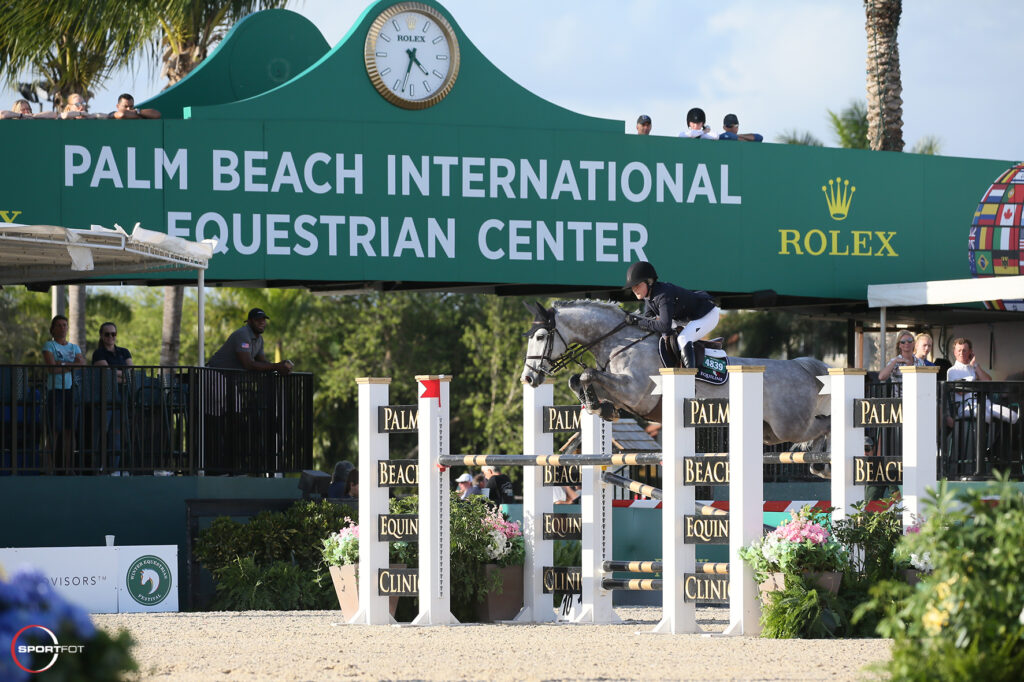
Sore feet can cause numerous problems elsewhere, according to Dr. Robert Brusie, head surgeon at Palm Beach Equine Clinic.
“The horses with sore feet tend to land funny, which can cause strained suspension ligaments or tendons,” says Dr. Brusie. “There also could be sore heels. Sore feet tend to make them short-strided and that could lead to a sore back and or a sore neck.”
Dr. Brusie says one way to notice a horse with sore feet, especially among jumpers, is their reluctance to jump the fences.
“That can be hard on the riders, too,” adds Dr. Brusie.
The foot is the closest to the environment and if you have a sore-footed horse, it could lead to lameness and poor performance, according to Dr. Brusie. Another possibility that could lead to sore feet is being too wet.
“Horses that are to show or play (polo) sometimes get two or three baths a day,” explains Dr. Brusie. Coupled with rings that are sprayed with water to help the footing can lead to problems, he said.
Both Dr. O’Grady and Dr. Brusie believe that taking proper care of your horse’s feet early helps the horses in the long run by eliminating other problems.

For over 30 years, Palm Beach Equine Clinic (PBEC) has offered an unwavering commitment to the care of your horse, whether an Olympic athlete or reliable trail horse. PBEC’s goal is to keep your horse healthy and happy while extending their performance career. PBEC offers innovative veterinary services with the assistance of state-of-the-art diagnostic tools and surgical equipment. They also offer several equine alternative therapies that can optimize your horse’s health and increase the longevity of their career.
Veterinary chiropractic manipulation, acupuncture, and Chinese herbal medicine are three alternatives to standard medical treatments offered at PBEC.
While all of PBEC’s 28 veterinarians are versed in all methodologies of equine medicine, several of the doctors have studied extensively in equine alternative therapies. Dr. Natalia Novoa treats horses with chiropractic manipulation and acupuncture. Dr. Janet Greenfield-Davis focuses specifically in acupuncture treatment and also uses Chinese herbal medicine to bring out the best in her patients.
PBEC’s Dr. Richard Wheeler spoke of how equine alternative medicine can be used to improve your horse’s chance for success and treat many different issues.
Alternative Therapies for Performance Horses
“The line between success and failure is very thin for performance horses, and a lot of these alternative therapies can be very useful to give the horse that little bit more,” Dr. Wheeler explained. “Chiropractic manipulation and acupuncture are two alternative therapies that we offer. They are both conjunctive therapies that can keep horses comfortable, happy and performing well.”


“Both chiropractic manipulation and acupuncture can get the horse moving a little bit better and can help to maintain some minor chronic problems that they may have, therefore avoiding more invasive treatments,” Dr. Wheeler continued. “For neck or back pain, once we diagnose a problem, we may treat it and then follow up with a program of equine alternative therapies. These therapies are used with the aim of keeping the horse supple, and moving with ease, and helping the musculature to work correctly. We work with the trainers to optimize muscle development so that we can fix the problem and keep the horse moving forward and performing at the top level.”
Equine Acupuncture
Dr. Janet Greenfield-Davis is one of the veterinarians at PBEC that is skilled in acupuncture and herbal medicine. Acupuncture is a form of treatment used in both traditional and classical Chinese medicine. It is based on the principle that there are energetic pathways, or channels, throughout the body that influence associated internal organs and structures. Energy from these pathways surface at various points on the body, identified as acupuncture points. Extremely fine gauge needles are inserted at selected points, stimulating these points and thereby activating the body’s natural healing abilities.
“We offer acupuncture, chiropractic and herbal medicine as an alternative or adjunct therapy to your current veterinary protocol,” Dr. Greenfield-Davis explained. “With acupuncture, we stimulate particular points that can relieve pain, increase endorphins, calm, and improve health and body function in horses. These specific points have a high capacity of nerve endings, lymphatic vessels, and blood vessels, as well as hormone stimulation.”
Clinical trials indicate that acupuncture may be an effective adjunct therapy for musculoskeletal problems, such as muscle soreness, back pain, disc problems, osteoarthritis, and degenerative joint disease. Acupuncture may help neurological disorders, such as laryngeal hemiplegia, and facial and radial nerve paralysis. It can help with gastrointestinal disorders, such as diarrhea, gastric ulcers, colic, and impaction. Acupuncture may also help with respiratory diseases, metabolic and endocrine diseases, and other chronic conditions, such as anhidrosis, heaves, asthma, cough, uveitis, and behavioral problems.
Equine alternative therapies such as acupuncture and chiropractic manipulation have gained popularity over the past years. Offering these therapies allows PBEC to treat horses in other ways in addition to their standard practices of equine medicine. Dr. Natalia Novoa is one of the veterinarians at PBEC who offers both chiropractic and acupuncture therapies for clients.
Veterinary Chiropractic Manipulation
“Chiropractic is an excellent complementary modality that can be used for diagnosis, treatment, and prevention of selected neuromusculoskeletal disorders,” Dr. Novoa explained. “The practice of chiropractic focuses on the relationship between structure (primary spinal column) and function (coordinated by the nervous system) to restore it. The goal is to treat soft tissue injuries or articular dysfunction to optimize health through manual therapy and to detect and treat abnormalities and alleviate pain.”


Veterinary chiropractic manipulation is thought to optimize equine health by restoring the normal joint motion, reversing mild pathology, and helping to slow the progression of degenerative joint and spine disease. Over the years, this therapy has become a valuable adjunct for competition horses.
Chiropractic manipulation is also a great treatment option for horses that suffer neck and back pain, nerve damage, poor performance, behavioral problems, muscle spasms, localized or regional joint stiffness, unexplained lameness, gait abnormalities asymmetry/muscle imbalance/atrophy, injuries resulting from falls, trauma (such as slips, getting cast in the stall, or missteps), or poor fitting equipment.
“I identify the restricted movement or subluxations by manipulating and evaluating the joint mobilization. Then I restore the joint motion with an adjustment which is a manual controlled force applied to a specific joint,” Dr. Novoa said of the process.
Complementary Sport Horse Medicine
Chiropractic and acupuncture therapies are complementary treatments for lameness problems and other issue. They are alternative methods and do not replace conventional veterinary medicine or surgery, but can be very useful in maintaining top performance levels in your horse.
“There has been an increase of interest in non-traditional therapy, and PBEC is aware of its great value, so we provide the services to allow our horses to reach maximum performance potential and overall health,” Dr. Novoa concluded.
Palm Beach Equine Clinic provides experience, knowledge, availability, and the very best care for the horses of Wellington. Have them be a part of your team! To find out more, please visit www.EquineClinic.com or call 561-793-1599.
As the official veterinarians of the Winter Equestrian Festival (WEF) and Adequan® Global Dressage Festival (AGDF) in Wellington, FL, Palm Beach Equine Clinic welcomes all veterinarians, local and worldwide, to utilize their services and facilities throughout the winter season.
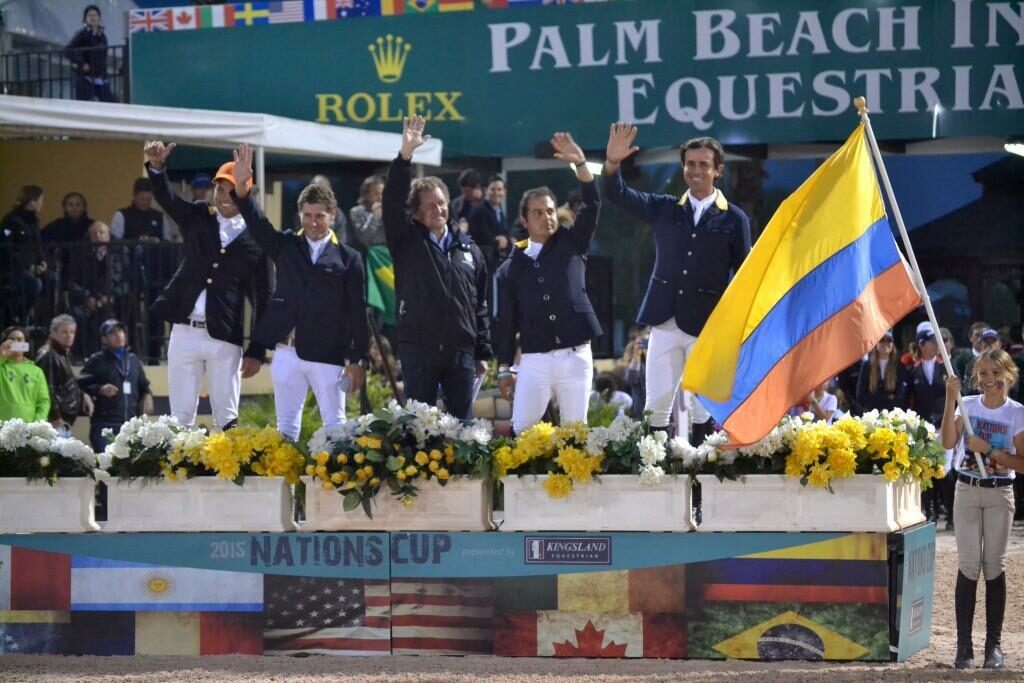
Locating Riding Distance from the Horse Show
Located just down the road from the Palm Beach International Equestrian Center (PBIEC), PBEC offers state-of-the-art surgical tools, highly advanced diagnostic imaging equipment, three board-certified surgeons, one of the top board-certified equine radiologists in the country, and 28 accomplished and knowledgeable veterinarians available to treat clientele of any discipline.
During the winter season, the veterinarians of PBEC donate their time and services to the world-class competitors of the Winter Equestrian Festival. Week eight of the 12-week WEF circuit is currently underway with CSIO competition, and PBEC welcomes the international team veterinarians to make use of their services as horses and riders compete in the prestigious Nations’ Cup classes.
Horse and rider teams from all around the world will be competing in the esteemed senior Nations’ Cup on Friday night, March 4, beginning at 7 p.m. Hollow Creek Farm will be hosting the Children’s, Junior and Young Rider FEI Nations’ Cup team events on Saturday evening, March 5, 2016. The teams have flown from over ten different countries throughout South America, North America, and abroad to compete this week.
Proud to be Part of Prestigious Competiton
For PBEC President, Dr. Scott Swerdlin, the Nations’ Cup events provide some of the most exciting competition of the circuit and he is proud to have his veterinarians well-represented.
“Those two nights that we have the Nations’ Cup classes, everyone is so competitive and proud of their country and proud of the horses in their country,” said Dr. Swerdlin. “Nations’ Cup week is one of the highlights of WEF and we really appreciate having the opportunity to be supportive of all of the teams. For us, it is just a privilege to be a part of such a special competition. We enjoy working with the different veterinarians and they are always welcome to come to PBEC if they are traveling with a team. Our motto is ‘Make us a part of your team,’ and we hope that visiting doctors will take advantage of the world-class services that we have to offer.”
All-Inclusive Equine Hospital, Imaging and Emergency Services
PBEC’s Dr. Richard Wheeler spoke of the support that the clinic is able to provide to the teams as they compete throughout the week in Nations’ Cup classes.
“Being a full-service facility, we are proud to provide support to the international teams,” said Dr. Wheeler. “It is great to see the international horse community come together and it is fun for us to build relationships with vets from all over the world. We often have vets come to visit us and spend time in our hospital, and likewise, we visit them in their facilities.

“We are here to support them,” Dr. Wheeler continued. “In an emergency situation, we are here to provide hospitalization and ambulatory services. We offer advanced imaging services such as MRI and Nuclear Scintigraphy, we have a fantastic team of internal medicine specialists that includes three board-certified surgeons, and we have one of very few board certified equine radiologists in the world.”

Dr. Wheeler added, “PBEC always has a veterinarian on the show grounds any time competition is going on. We also have a new Annex office on the show grounds this year so that the doctors can quickly and safely treat horses in a clean environment. The hospital is then ready for emergencies 24/7, with specialists, equipment, and personnel ready to handle any situation.”
Surgical Services Available When Needed
PBEC Staff Surgeon Dr. Jorge Gomez serves as the team veterinarian for Colombia and Venezuela. Dr. Gomez finds his partnership with PBEC very important throughout the season.
Dr. Gomez explained his responsibilities as team vet, stating, “I am in charge of the health and soundness of the horses in the team. Before the events, and once the horses for the team are chosen, I look at all of the team horses individually to make sure the horses are in good condition to compete. We check all the health papers and passports to make sure they are up to date. During the competition days, I perform horse inspections before and after every class. In conjunction with the grooms, we also make sure that the horses are in normal condition with no modifications of their normal behavior.”
If there are any concerns of a horse’s well-being, Dr. Gomez and all of the team veterinarians have the diagnostic services of PBEC at their fingertips. Along with the advanced imaging capabilities and emergency surgical services, teams can make use of PBEC’s niche offerings, such as chiropractic care or acupuncture as well.
Palm Beach Equine Clinic provides experience, knowledge, availability, and the very best care for the horses of Wellington. Have them be a part of your team!
Palm Beach Equine Clinic (PBEC) is one of the few equine hospitals in the country to have a full-time radiologist on-site during season. With the addition of Dr. Sarah Puchalski to their staff, as well as the installation of the most state-of-the-art imaging equipment, Palm Beach Equine Clinic has become a leader in diagnostic sport horse imaging.
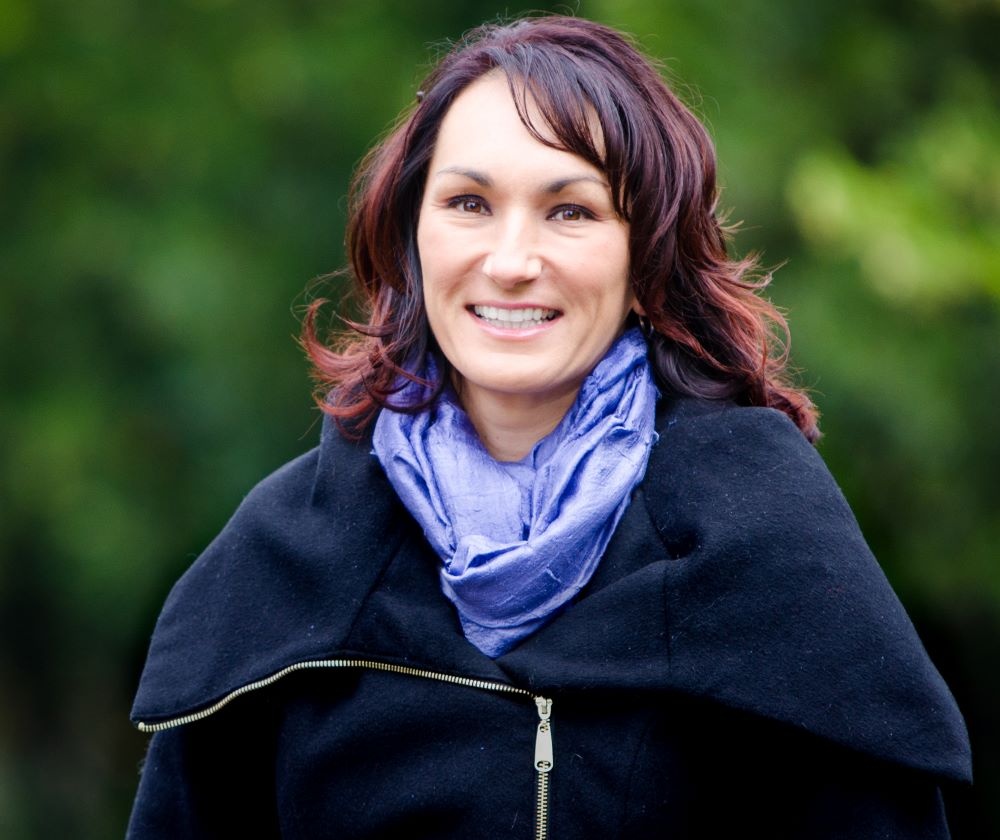
Dr. Puchalski is one of very few board-certified equine Radiologists in the country and one of the most high profile of those in the world. Early in her career, Dr. Puchalski earned the respect of the best in the industry and strives to continue to contribute advances for equine sports medicine and diagnostic imaging.
Dr. Puchalski’s job takes extensive training and a high level of specialization to properly review diagnostic imaging, including MRIs and Nuclear Scintigraphy bone scans to produce written reports for referring veterinarians. In addition to her full-time position with Palm Beach Equine Clinic, she reads cases from all over the world on a daily basis. Many veterinarians and owners request to consult with her for a second opinion.
Potential for Growth
After eight years working as a faculty member at the University of California Davis, Dr. Puchalski decided to take a job with Palm Beach Equine Clinic in December 2013. She had been consulting on Palm Beach Equine Clinic cases for several years prior to the move and felt it was a natural progression. Palm Beach Equine Clinic made huge advances to their in-house imaging technology under her direction.
Almost 30 years ago, Palm Beach Equine Clinic bought the first ultrasound for equine practice in South Florida. Twenty-five years ago, Palm Beach Equine Clinic installed the first gamma ray camera to perform bone scans (Nuclear Scintigraphy). Twenty years ago Palm Beach Equine Clinic developed Computed Radiography (CR) for horses. Currently, Palm Beach Equine Clinic has the most advanced state-of-the-art surgical and diagnostic imaging equipment available. Onsite, they have a Hallmarq standing equine MRI unit, MiE gamma ray camera, Digital Radiography, Video Endoscopy, and a bevy of additional diagnostic equipment.
“ Palm Beach Equine Clinic has a great case population and great equipment, which is a huge bonus for someone doing what I do,” Dr. Puchalski stated. “The equipment is exceptional, the technical staff is excellent, and the case population of the region is obviously amazing.”
Palm Beach Equine Clinic is dedicated to providing exceptional veterinary service for the horse, and Dr. Puchalski proudly supports that mission through her work. She diagnoses issues from complicated images that assist veterinarians in the proper, effective treatment plan. She is able to provide a second opinion on routine diagnostic techniques such as radiographs and ultrasounds. She is also able to provide diagnostic reports for pre-purchase examinations based on the imaging submitted.
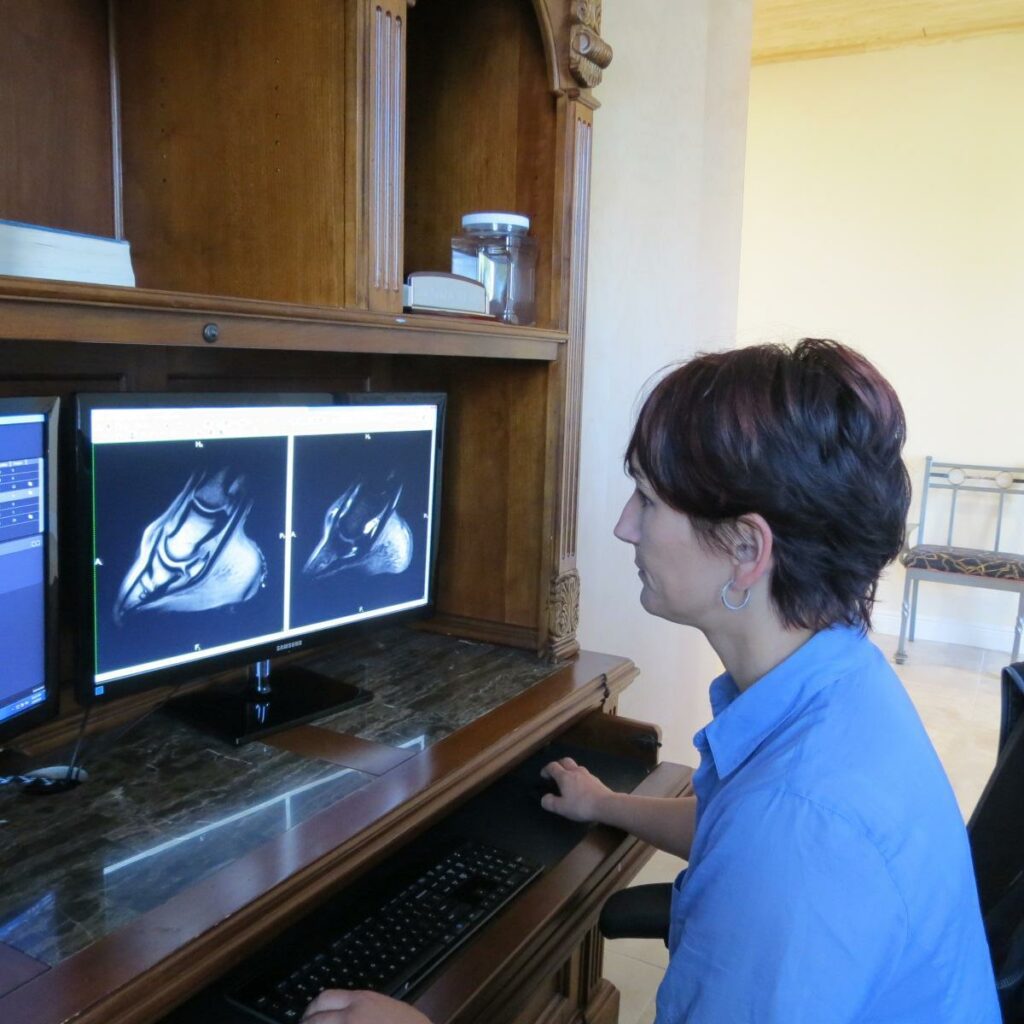
For Dr. Puchalski, the potential for future growth in diagnostic imaging services at Palm Beach Equine Clinic is huge.
“There are new technologies coming into the market for imaging all of the time and Palm Beach Equine Clinic will remain abreast of those advances,” Dr. Puchalski said. “Going forward, we are looking to acquire new equipment, and I think it is fair to say that the hospital will see an increasing role with different kinds of cases. There are a lot of changes in the market that occur very quickly, so we are always trying to figure out the best thing for this practice.”
Finding Time to Ride
In addition to working with PBEC locally and assisting veterinarians around the world, Dr. Puchalski competes her Oldenburg mare, Lucia de Luxe, in the Medium and High Amateur-Owner Jumpers.
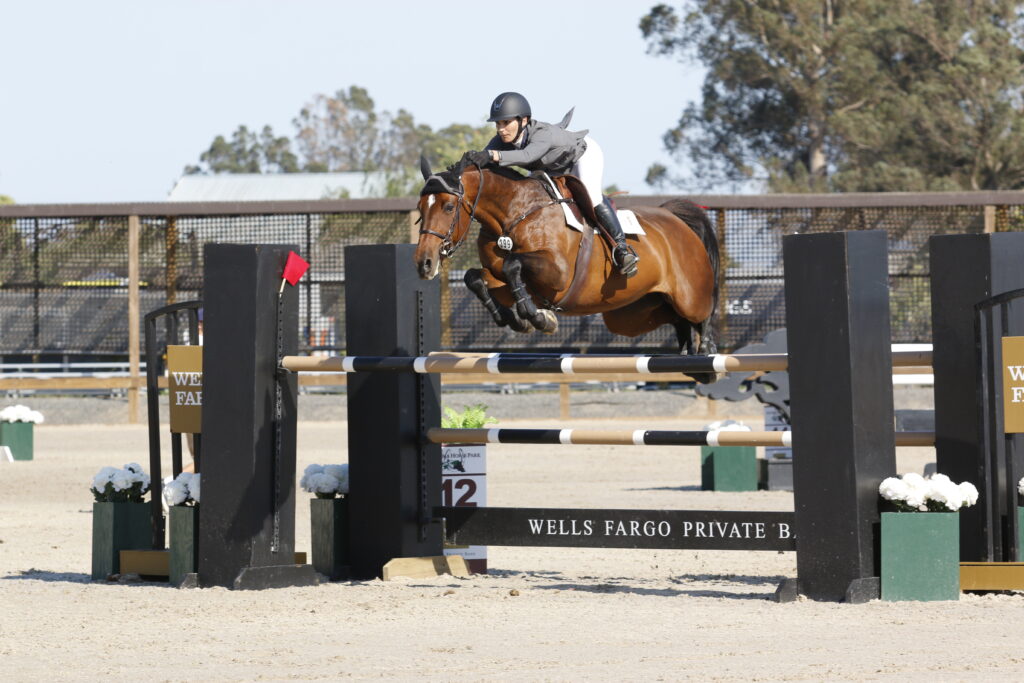
Dr. Puchalski splits her time throughout the year between her homes in California and Florida. She is based in Wellington for about five months, and enjoys competing at the Winter Equestrian Festival, for which PBEC serves as the official veterinarians.
Although her horse is currently injured, Dr. Puchalski normally rides every day and enjoys the flexibility of her job that supports her riding schedule.
“One of the best parts of what I do is the flexible schedule,” she admitted. “I try to ride every day and fit everything else around it. I can really do my job from anywhere. It can be completely web-based, which I love.”
“First thing in the morning, I check into the clinic and check on the imaging cases for the day,” Dr. Puchalski detailed. “I usually read some MRI and Nuclear Scintigraphy cases and then go ride mid-morning. Then I come back and read cases for my other clients. PBEC is a big chunk of my work, but a lot of my cases also come from global clients; I have clients all over the world.”
From a Small Town to Big Dreams
Dr. Puchalski grew up on a small-town acreage in British Columbia and started riding at a very young age. She got her first pony when she was four years old and continued riding at a three-day eventing barn next door to her home. Early on, Dr. Puchalski knew that she wanted to be a veterinarian. Dr. Puchalski graduated with a BS in Biology from Simon Fraser University in British Columbia, and completed her Doctorate of Veterinary Medicine from the University of Saskatchewan in Saskatoon. She interned in Field Service and Sports Medicine at New Bolton Center at the University of Pennsylvania, and completed her residency in Radiology at UC Davis in 2005.
During her internship at the New Bolton Center, Dr. Puchalski decided to pursue a career as a Radiologist thanks in part to one of her valued mentors, Virginia Reef, at the University of Pennsylvania.
“Dr. Reef was a huge influence on my career direction at that stage,” Dr. Puchalski noted. “Ginny was an influence in me becoming a radiologist, and then as a radiologist, I was mentored by Tim O’Brien at UC Davis – he is a founding father of equine radiology.”
Continuing to Have an Influence
Prior to joining PBEC in 2013, Dr. Puchalski spent eight years on the faculty of UC Davis providing research instruction and clinical service. Dr. Puchalski has published many scientific articles in diagnostic imaging and equine injuries which was a huge component of her early career.
“Once you have published research, the spinoff is then to publish in textbooks and other literature, so I have done a number of chapters for major lameness and diagnostic imaging textbooks as well,” Dr. Puchalski explained. “I have published more than 50 scientific articles and performed over 100 presentations all over the world on lameness diagnosis and diagnostic imaging in sport horses. I am currently trying really hard to still publish study results and be involved with universities, but also have a very busy private practice caseload.”
Outside of work and horses, Dr. Puchalski enjoys the challenges of Crossfit. In addition to her time spent in Florida and California, she also spends several weeks every summer working and showing at Spruce Meadows in Calgary, Alberta, Canada.
Dr. Puchalski is an integral part of the team at Palm Beach Equine Clinic and will continue to serve PBEC’s clientele as diagnostic imaging advances into the future.
Palm Beach Equine Clinic provides experience, knowledge, availability, and the very best care for the horses of Wellington. Have them be a part of your team! To find out more, please visit www.EquineClinic.com or call 561-793-1599. “Like” them on Facebook to follow along on what happens in Wellington and more, and get news from their Twitter!
More About Dr. Sarah Puchalski
Dr. Puchalski is a Diplomate of the American College of Veterinary Radiology whose specialty includes the interpretation of radiographs in addition to other diagnostic imaging techniques.
Dr. Puchalski is from Davis, CA, where she was an associate professor at the University of California in their Department of Surgical and Radiological Sciences. In 1995, she received her BSc in biology from Simon Fraser University in British Columbia, and in 1999 earned her Doctor of Veterinary Medicine from the University of Saskatchewan in Saskatoon, where she received the ACVS Outstanding Large Animal Surgery Student award that same year. Dr. Puchalski interned in Field Service and Sports Medicine at New Bolton Center at the University of Pennsylvania in 2001, and completed her residency in radiology at UC Davis in 2005.
Dr. Puchalski has devoted her career to teaching and improving equine health through the development and refinement of diagnostic techniques. In 2011 she contributed to two books on the topic of equine lameness. Her recent contributions include chapters in Diagnosis and Management of Lameness in the Horse edited by Ross and Dyson, as well as in Veterinary Computed Tomography and the Clinical Veterinary Advisor: The Horse, Equine Colic and Veterinary Clinics of North America. She also has contributed close to 50 scientific articles concerning the diagnosis of equine lameness to many periodic journals, including Veterinary Radiology & Ultrasound: the official journal of the American College of Veterinary Radiology and the International Veterinary Radiology Association; Veterinary Pathology; Equine Veterinary Journal; the American Journal of Veterinary Research; Equine Veterinary Education; Journal of the American Veterinary Medical Association; and Journal of Veterinary Internal Medicine.
This fall, the United States Equestrian Federation (USEF) unveiled its latest health rule requiring all horses entering a Federation-licensed competition be accompanied by documentation of Equine Influenza Virus (flu) and Equine Herpes Virus (rhinopneumonitis) vaccinations within six months of being stabled at the show. Now approaching a month of enforcement during the 2016 winter show season, the new vaccination requirements enacted by the USEF gave structure to requirements that were previously being developed and enforced on a show-by-show basis.
After Florida’s Equine Herpes (EHV) scare in February of 2013, horse show facilities began adopting vaccination requirements of their own, usually requiring EHV-1 and EHV-4 vaccines within 90 to 120 days of a horse’s arrival to the grounds.
Now, USEF specifically requires all licensed competitions comply with the same set of requirements while not increasing the workload for competition management. The six-month timeline also matches the operating procedures of international shows overseen by the FEI as well.
According to Palm Beach Equine Clinic’s own Dr. Richard Wheeler, the rule change simply makes sense.
“Most people regularly vaccinate their horses every six months anyway, so this rule should not present a disruption to current practices,” he said. “After the 2013 scare, competitions recognized the potential of closure due to infectious disease and started creating requirements which became inconsistent between shows.”
Whether directly or indirectly affected by rule change itself, an increase in awareness regarding equine infectious disease in recent years had minimized outbreaks, according to Dr. Wheeler.
“A good job is being done so far to keep a big problem away,” he added.
While efforts by the USEF, veterinarians, and horse owners alike have proved successful in keeping horses safe and healthy, Dr. Wheeler was quick to remind the equine community to not get complacent. He stresses the continuation of education and awareness.
“An increase in bio-security is the most significant benefit we’ve had as a result of these requirements,” he said. “This is the most protective measure that we have taken on as a community, and people are now cognizant of how disruptive bringing a sick horse to a show can be. We see people getting vets involved quickly and shows doing a good job of providing isolation. What’s been done in the past few years is a positive thing, but it’s important that we don’t let our guard down because we haven’t had an outbreak in a few years.”


In addition to abiding by the USEF’s six-month rule, Dr. Wheeler also suggests the individuals responsible for caring for horses continue their efforts past the gates of the facility.
“Horse shows are often condensed places and limiting the exposure of horses is difficult,” he said. “It’s important that we stay really aware, take temperatures regularly, identify sick horses, and isolate them immediately. It’s all key to prevent outbreaks.”
Thanks to regulations, always improving technology, educated veterinarians, and diligent horsemen and women, the equine community is becoming more guarded against infectious disease than ever before.
To read more about the USEF vaccination requirement, click here. The experts at Palm Beach Equine Clinic stand ready to answer any questions horse owners may have about vaccinations and the requirements needed for equestrian competitions.
Palm Beach Equine Clinic (PBEC) proudly serves as the official veterinarians of the world-renowned Winter Equestrian Festival (WEF) and Adequan® Global Dressage Festival (AGDF) in Wellington, FL. Adjacent to the Palm Beach International Equestrian Center in the heart of Wellington, PBEC’s state-of-the-art facilities and world-class team of 28 veterinarians are there for every equestrian’s needs throughout the WEF and AGDF circuits. PBEC is proud to work for its multi-discipline clientele with the aid of the most advanced technologies and medical treatments available.
Official Horse Show Veterinarian
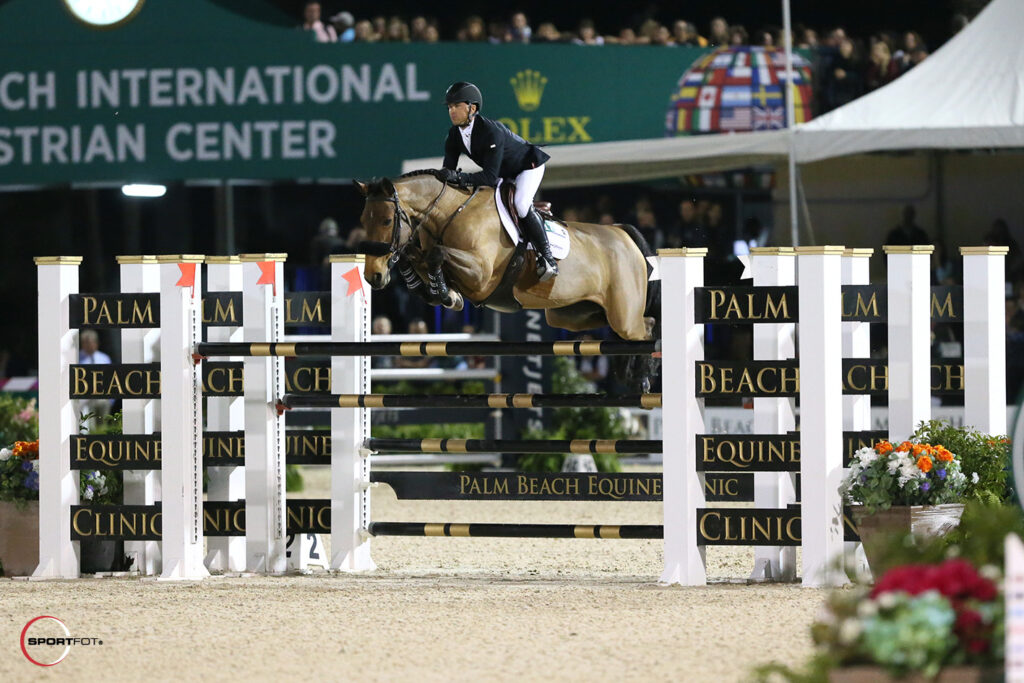
“Wellington is a fabulous place, and I have watched the growth of WEF as well as AGDF over the years, and it has been exponential,” said Dr. Scott Swerdlin, President of Palm Beach Equine Clinic. “For us to be part of that growth, and part of the explosion of the sport horse industry here in Wellington is a real honor. We want to give back to the community, as well as contribute to all of the great things that Mark Bellissimo has done for the horse show world.”
“I love to see the good horses return, and every year it seems like better and better horses are competing from all over the world,” Swerdlin added. “The quality of horses and the quality of competition always continues to improve. To watch these fabulous horse and rider combinations in all of these different disciplines is such a treat.”
Global Satellite Services
With top horses and riders from around the world spending their winters in Wellington, PBEC is proud to have veterinarians on the team that represent many different countries. PBEC currently employs veterinarians from Argentina, Uruguay, and Colombia. It is a privilege for the team at PBEC to work together with many of the best veterinarians from all over the world as they travel to Wellington with their clients.
All-Inclusive Equine Hospital
Palm Beach Equine Clinic features its full-service surgical center and intensive care hospital located only minutes from the Palm Beach International Equestrian Center show grounds. Board certified surgeons, primary care veterinarians and hospital technicians are scheduled for emergency on call assistance 24 hours a day, 365 days a year to treat, monitor and care for critical cases. With exceptional veterinarians and a staff of highly trained hospital technicians, PBEC’s surgical suite and staff are prepared to handle all kinds of emergencies, day and night.

The Palm Beach Equine Clinic facility houses the most advanced imaging technologies available, including a standing Magnetic Resonance Imaging (MRI), Nuclear Scintigraphy (Bone Scan), Ultrasonography, Digital Radiography and Endoscopy. PBEC is unique in that a Board Certified Radiologist is on site to interpret images and assist with diagnosis for rapid results. PBEC’s on-site, full-service laboratory equipped with hematology, chemistry, and microbiology equipment provides veterinarians with the ability to quickly evaluate blood tests for critical cases.
The newest addition this year for PBEC is the Annex Veterinary Office located on the show grounds at the Winter Equestrian Festival. The wooden barn located at the beginning of the north grounds entrance is now an office space, pharmacy for supplies and medication pick up, and examination areas.
For more information on the facility or in case of an emergency, please call (561) 793-1599 to contact an on-call veterinarian.
Palm Beach Equine Clinic’s Dr. Richard Wheeler recently shared the basic steps he takes in performing an equine pre-purchase exam.
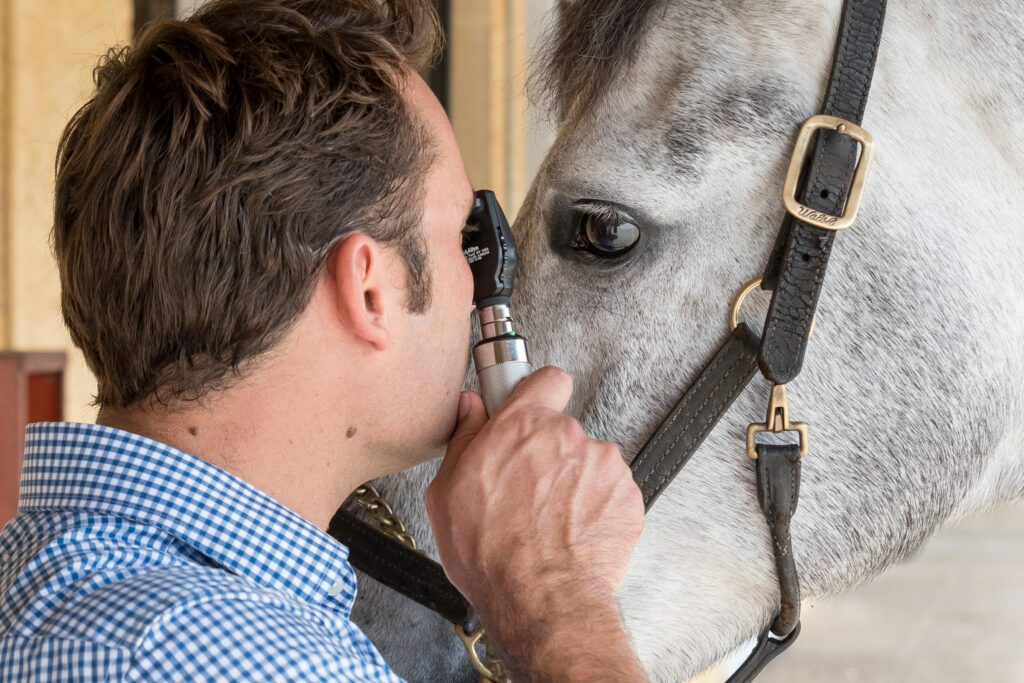
Dr. Wheeler and PBEC’s 28 veterinarians, including Board Certified surgeons, a internal medicine specialist and a radiologist, are considered some of the most experienced in treating equine athletes from all disciplines. Palm Beach Equine Clinic veterinarians enjoy the opportunity of working with top horses and riders at their home base in Wellington, FL, and through satellite services at competitions around the world.
With thousands of horses competing in Wellington at events such as the Winter Equestrian Festival and the Adequan® Global Dressage Festival, equine sales are a huge factor of equestrian businesses. Palm Beach Equine Clinic’s pre-purchase examination services are always available to assist in making the best decision on your next equine purchase.
No matter what the breed or discipline, pre-purchase exams include several basic initial steps. First, an overall health evaluation of the horse is completed, including previous health history, general condition, and conformation. The veterinarian examines specific body systems including the eyes, cardiovascular system and respiratory system.
Next, a lameness assessment is completed, including flexion tests, soft tissue structure palpation, and movement evaluation. Additional diagnostic imaging such as radiographs (x-rays), ultrasound, endoscopy, magnetic resonance imaging (MRI), or nuclear scintigraphy (bone scans) may be requested for additional information.
The goal of a pre-purchase exam is to assess its current state of the horse’s health and soundness at that time of the examination. Pre-purchase exams allow veterinarians to gather information that may help the owner and veterinarian predict a level of risk for the future use of the horse.
Steps Taken in a Pre-Purchase Exam
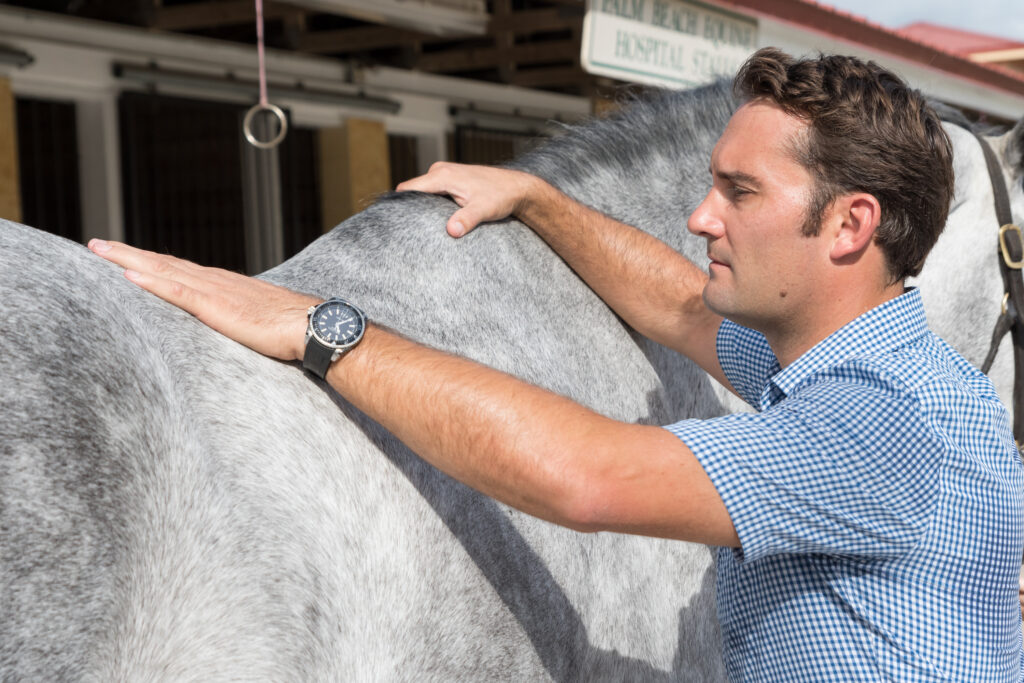
- “The first thing I do is talk to the potential buyer and trainer to gather their expectations and any concerns that have arisen during the trial of the horse. Next I discuss the horse with the current owner and/or trainer to determine what level of training or competition it is in, and if it has any previous issues that they are dealing with.”
- “Then we look at the horse in a static exam in the stall. We do a physical exam, looking at the whole body from front to back. Key points are the eyes, heart, and lungs and we palpate from the head and neck, to the back, and down the limbs. We are looking for signs of old injuries or areas that may have issues; conformation comes into play here as well.”
- “We want to look at the horse in a dynamic exam. We usually look at it on the lead line and on a lunge line, or trotting in a circle on hard and soft surfaces, and then also under saddle as well. I like to see all of my horses go under saddle because we can observe the interaction of horse and rider, which is very important. During this stage we will perform flexion tests and ask the horse to perform specific movements depending on the discipline.”
- Blood tests are often taken and normally will include CBC, Chemistry, Coggins test and a drug screen. Depending of the age or type of horse other tests may be performed.
- “Finally, there are some auxiliary tests, which may include radiographs, ultrasound exams, and endoscopy of the upper airways. These days, if there are certain issues, we will also include further diagnostic tests such as MRIs or bone scans. That depends on what is found in other parts of the exam. If there is something suspicious on a radiograph, the buyer might want to do more advanced imaging. Or sometimes, depending on the value of the horse, they might want to do that anyway.”
A Comprehensive Profile of the Horse
Dr. Wheeler pointed out that it is not the intention of a pre-purchase exam to recommend the horse for purchase or for sale. The exam is performed to provide information about the level of risk and educate the client of that risk. The client will make the decision on whether they want to buy the horse or not based on the information the veterinarian has provided as well as information from their trainer.
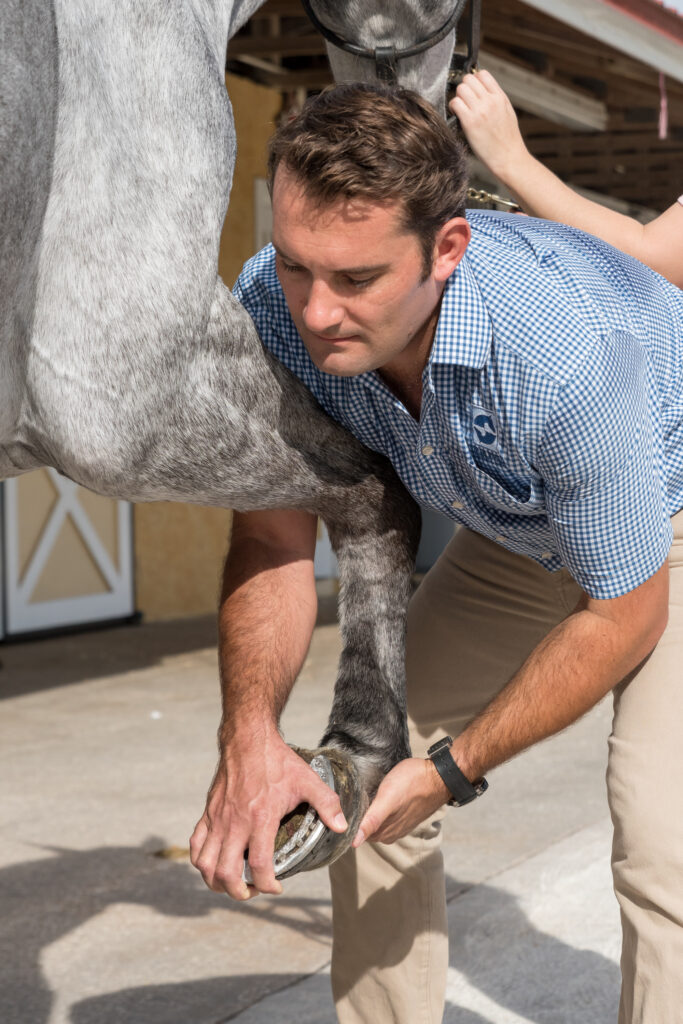
“What might be acceptable for you may not be for me, or vice versa, depending on what I want the horse for or the value of the horse,” Dr. Wheeler noted.
“It is not a pass/fail situation. We are just describing the horse, doing our best to state whether the issues that it has can be maintained or can be useful for the horse’s given profession, and what is expected of it, and this is where experience is so important. If the horse is being purchased as a low level children’s show horse, the stresses on it are going to be less than if it is being asked to go to the Olympics.”
Every exam is different, but the basic steps of evaluating a horse for any discipline or level of competition are fairly standard. It is important to have a veterinarian who is experienced and knowledgeable with the specific discipline to provide accurate guidance on the horse’s condition for the expected job. For the clientele of Palm Beach Equine Clinic, the veterinarians are all well-schooled in the different disciplines, and many have additional expertise in specific areas.
The world-renowned veterinarians of PBEC will be sharing their expertise on equine pre-purchase exams in a four-part series featured exclusively on ProEquest from February through April 2016. Located in the heart of Wellington, FL, Palm Beach Equine Clinic serves multi-discipline clientele at equestrian competitions throughout North America and abroad. To schedule a pre-purchase exam with one of Palm Beach Equine Clinic’s top veterinarians call 561-793-1599.
About Dr. Richard Wheeler

Dr. Wheeler graduated from the Royal Veterinary College in London in 2002. He spent his first two years of practice as an intern at Greenwood, Ellis and Partners in Newmarket, England, where he worked in a referral center specializing in the treatment of Thoroughbred racehorses and Sport Horses. Dr. Wheeler moved to Palm Beach Equine Clinic in 2005 and became a partner in 2009. Dr. Wheeler’s clients include Jumpers, Dressage and Polo and he is licensed to practice in FL, KY, NC and NY and also the UK and Europe.
Equine Internships and Externships for Veterinary Students and Graduates

While Palm Beach Equine Clinic may be known for the 28 superb veterinarians who call it home, they are also a driving force in educating the next generation of equine medical professionals. Through world-renowned equine internship and externship programs, Palm Beach Equine Clinic molds new veterinarians every day.
Each year, equine interns work with Palm Beach Equine Clinic veterinarians for a 12-month period. Whether from externships that usually last up to two weeks and serve as an introduction to the practice or by references from top veterinarians across the U.S. and abroad, Palm Beach Equine Clinic attracts the most promising young veterinarians in the field.
Educating Equine Veterinary Students and Graduates From Around the World
Currently, Palm Beach Equine Clinic is host to recently graduated veterinary students from Oklahoma, Scotland, and Argentina. According to Palm Beach Equine Clinic veterinarian and board-certified surgeon Dr. Weston Davis who leads the Internship program, South Florida attracts only the best.
“We really have the cream of the crop because they have big opportunities here,” said Dr. Davis. “A lot of equine internships can offer work with one or two veterinarians, but what’s cool at Palm Beach Equine Clinic is they can pick from the collection of doctors we have.”
Palm Beach Equine Clinic interns rotate through three phases, including hands-on application of hospital anesthetization, imaging – both from ambulatory duty and elective – and working with a doctor of their choice based on their specific interests.

Dr. Davis has been with Palm Beach Equine Clinic for two years and immediately took interest in making the equine internship program the best it could be. In two years, he has made one of the world’s best programs even better.
Benefits of an Equine Internship
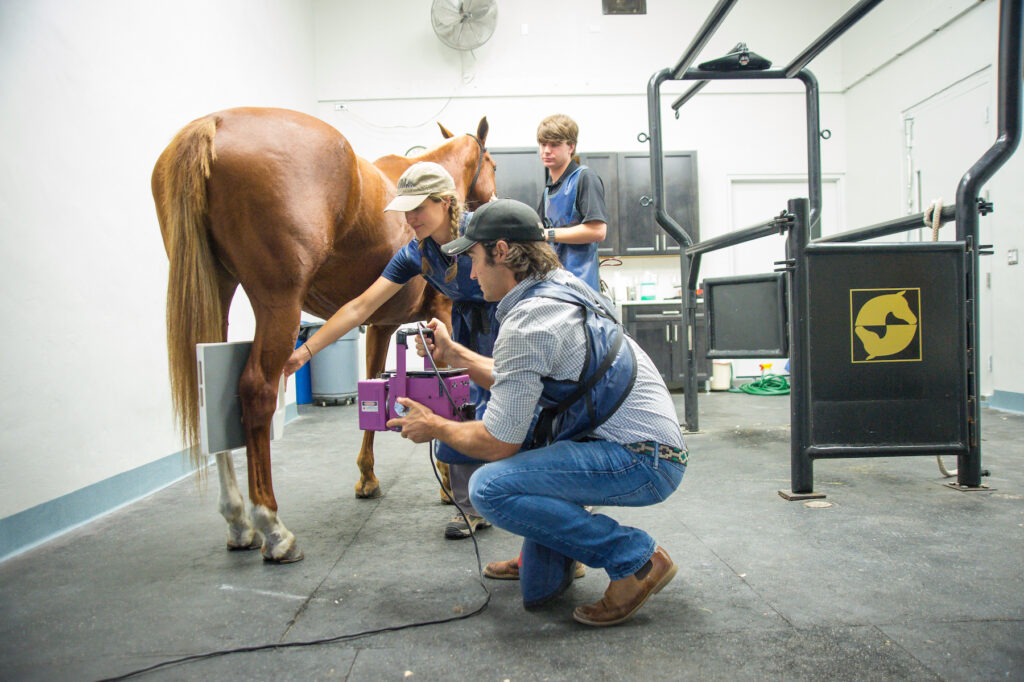
“I wanted to make it as organized and structured as it could be so they can get as much out of that year as possible,” he said. “The general rule is that doing a one-year equine internship puts you three to five years ahead of those that come out of school and start out on their own. Interns come out of school with a handle on book knowledge and the internships give them a good clinical appreciation for those same topics. They see a lot and do a lot under the supervision of seasoned veterinarians while they are here.”
While Palm Beach Equine internships offer obvious perks for the interns themselves, it also has added benefit for the veterinarians already at the clinic.
“The value for the interns is they get to see a tremendous amount of cases in short time, but it’s also valuable for us because they come out of school with fresh knowledge, new ideas, and keep us current and on our toes,” said Dr. Davis.
Traditionally veterinary students will fulfill their equine internship requirements and move on to find a full-time position at other practices. Dr. Davis himself did just that after graduating from the University of Florida College Of Veterinary Medicine and interning at Oakridge Equine Hospital in Oklahoma. But, the experiences available at Palm Beach Equine Clinic keep its interns staying put.
Equine Internships Kickstart Veterinary Careers
History has proven that many interns who work for Palm Beach Equine Clinic as interns go on to accept full-time positions at the clinic. One of those veterinarians is Dr. Ryan Lukens. After earning his DVM from The Ohio State University College of Veterinary Medicine, he began an internship with Palm Beach Equine Clinic in 2012.
“I am so pleased that I did my internship with Palm Beach Equine,” said Dr. Lukens. “It was basically another year of school where I got to focus on exactly what I wanted to do.”
Dr. Lukens specialized in sports medicine, lameness, and diagnostic imaging, which is a passion he inherited from his father, a fellow veterinarian. His experience with Palm Beach Equine Clinic solidified that concentration thanks to the latest in veterinary technology.
“When I came to Palm Beach Equine Clinic, I had access to all the newest equipment. That gave me more tools to improve my skills under the direction of a full network of senior veterinarians,” added Dr. Lukens. “When you leave vet school, you have a question every hour of the day, and I had a number of veterinarians who were a phone call away to answer those questions. I never had to second-guess myself because they were there to help me learn. But, there also isn’t always one way to do something correctly. I learned the opinions of so many veterinarians who do things just a little differently, and it helped me to find my own way and what’s best for the horses I treat.”

Thanks to Palm Beach Equine Clinic, horse owners in South Florida and beyond have access to well-educated veterinarians with hands-on experience that is unmatched.
Interested in Applying for an Equine Internship?
Fill out this form to get in contact with the internship and externship department.
Palm Beach Equine Clinic is renowned for its full-service surgical center and intensive care hospital located in the heart of Wellington, Florida. Board certified surgeons, primary care veterinarians and hospital technicians are scheduled 24 hours a day, 365 days a year to treat, monitor and care for critical cases. With world class veterinarians and a full staff of highly trained technicians, both clients and patients of Palm Beach Equine Clinic are in the best hands possible.

Equine Hospital and Surgical Facility
Palm Beach Equine Clinic’s surgical suite and staff is prepared to handle all kinds of emergencies, day and night. The large team of 26 veterinarians includes three Board Certified Surgeons who rotate on-call duties for all emergencies. This aids Palm Beach Equine Clinic veterinarians and all of the Southeast with the ability to treat their emergencies quickly, especially any requiring surgical assistance. The state of the art intensive care hospital is equipped with digital video cameras for the clinicians to easily monitor their patients from any location, at any time. Palm Beach Equine Clinic also has a full-service laboratory on-site equipped with hematology, chemistry, and microbiology equipment to internally evaluate each case and provide rapid results.
Advanced Diagnostic Imaging Capabilities
Palm Beach Equine Clinic prides itself as a consistent leader in horse sport medicine and recently upgraded its scanning technologies to provide better equine diagnostic imaging services for their clients.
Last fall, Palm Beach Equine Clinic installed a state-of-the-art MRI lab containing the Equine Standing MRI manufactured by Hallmarq, which allows scans of the equine foot and lower limb to be done in a standing position requiring only light sedation. Additionally, last year Palm Beach Equine Clinic completed the renovation of a Nuclear Scintigraphy lab with the installation of the new top of-the-line MiE Equine Nuclear Scintigraphy camera. This new gamma ray camera is designed with sharper contours for more precise imaging and lameness diagnosis. The advanced technology provides the ability to acquire high quality images regardless of small patient movements, alleviating the necessity for re-scans and reduces the time required to complete a scan. Both MRI and Nuclear Scintigraphy can be extremely useful in diagnosing lameness origins and determining appropriate, effective treatment for your horse. Palm Beach Equine Clinic has a Board Certified Radiologist on site to interpret images to assist with diagnosis.
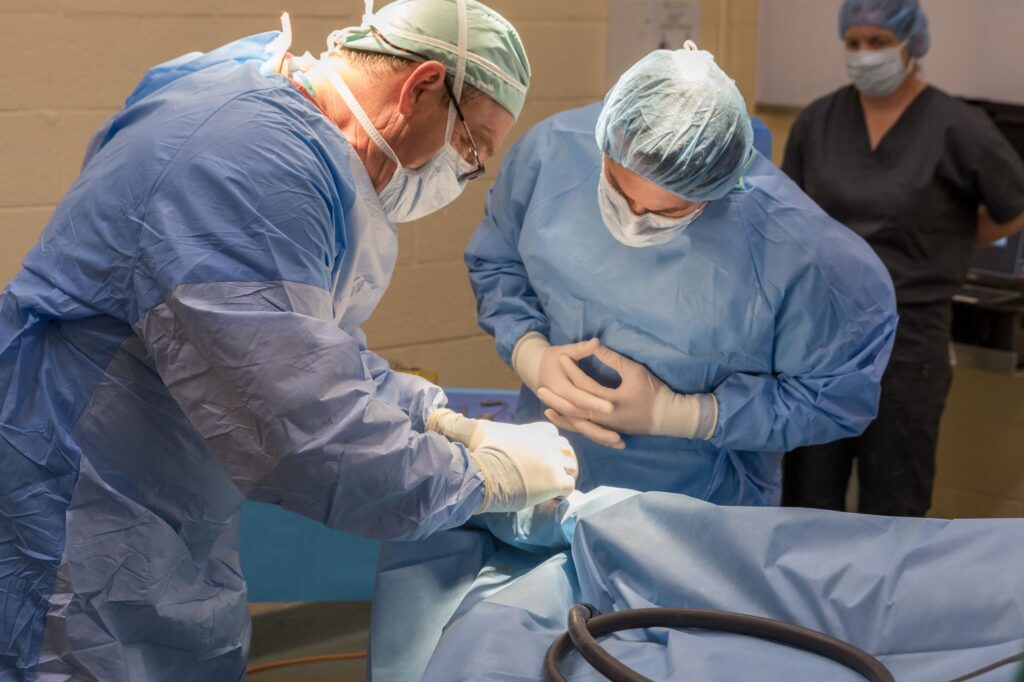

For Palm Beach Equine Clinic, 2016 will be an exciting year for expansion of our physical facility. PBEC plans on adding an additional 4,000 square feet of air conditioned examination areas, an additional surgical suite and recovery stall, as well as, climate controlled isolation quarantine stalls. Under the guidance of Dr. Sarah Puchalski, our in house Board Certified Radiologist, Palm Beach Equine Clinic hopes to add the first equine Computed Tomography service (CT scans) to our diagnostic imaging expertise.
Consult Palm Beach Equine Clinic for your Horse Health Needs
For more information on our facility or in case of an emergency, please call (561) 793-1599 to contact an on-call veterinarian.
